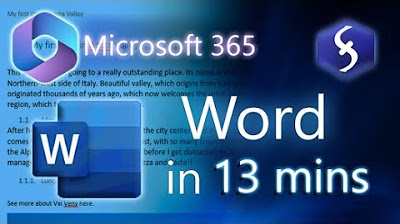Vim As Your Editor - Vertical Movements
Summary
TLDRThis Vim tutorial focuses on mastering vertical movements for efficient text navigation. It covers basic motions like 'j' and 'k', using relative line numbers for precise jumps, and the limitations of paragraph-based movements. The instructor recommends using Ctrl+D and Ctrl+U for half-page jumps, enhanced by centering the view with 'ZZ'. The video also touches on searching techniques, using '/' and '?' for forward and reverse searches, and the asterisk and pound sign for quick searches based on the current word. The importance of practice and customization for an optimized editing experience is emphasized.
Takeaways
- 🔍 **Horizontal Movements Recap**: The video references previous episodes about horizontal movements in Vim, emphasizing the importance of revisiting foundational skills.
- 👍 **Encouragement to Subscribe**: The presenter prompts viewers to subscribe for updates on the multi-part series, indicating more content is forthcoming.
- 📚 **Vertical Movements Focus**: The main topic of this episode is vertical movements in Vim, which is crucial for efficient navigation through code.
- 🔢 **Using Counts with Movements**: The video explains how to use counts with motions like 'j' and 'k' to move the cursor down or up by a specific number of lines.
- 📏 **Relative Line Numbers Utility**: It's highlighted that relative line numbers are beneficial for precise cursor placement within the visible text area.
- 💡 **Practical Tips on Practice**: The presenter stresses the importance of practicing movements to make them second nature, rather than consciously thinking about them.
- 📈 **Avoiding Guesswork**: The video advises against guessing line numbers and instead using more precise methods to navigate code.
- 📑 **Paragraph Navigation**: It's mentioned that moving by paragraphs can be useful but is dependent on how code is formatted, which can be inconsistent.
- 🔄 **Preference for Page Navigation**: The presenter shares a personal preference for using 'Ctrl D' and 'Ctrl U' for half-page navigation over other methods.
- 🖥️ **Centering the View**: A tip is given on how to center the view after moving, which enhances the efficiency of page navigation.
- 🔝 **Quick Access to Top/Bottom**: The video mentions using 'G' and 'gg' for quick navigation to the bottom and top of the document, respectively.
- 🔎 **Power of Searching**: Searching is highlighted as a powerful tool in Vim, with demonstrations of forward and reverse searches.
- 🔒 **Customization and Personalization**: The presenter encourages viewers to customize their Vim setup to optimize their editing experience.
- 🚀 **Continuous Improvement**: The video concludes with a motivational note on the importance of continuous learning and improvement in the field of engineering and using text editors.
Q & A
What is the main focus of the Vim tutorial series part three?
-The main focus of Vim tutorial series part three is on vertical movements within Vim.
What was the content of the previous parts of the Vim tutorial series?
-Part one laid the groundwork for Vim and part two was about horizontal movements.
What is the significance of the 'anatomy of a motion' mentioned in the script?
-The 'anatomy of a motion' refers to the structure of a Vim command, which includes a count and the motion itself, such as '5j' to move down five lines.
How does the use of relative line numbers assist in vertical movements in Vim?
-Relative line numbers allow users to jump exactly to the desired line, making it easier to navigate the document.
What is the issue with moving by paragraphs in Vim as described in the script?
-The issue with moving by paragraphs is that it depends on how the code is formatted, which can lead to jumping to unintended locations if the code is spaced out differently.
Why did the presenter change their preference from moving by paragraphs to using control D and control U?
-The presenter changed their preference because moving by paragraphs can be inconsistent due to varying code formatting, whereas control D and control U provide more predictable and centered movements.
What is the effect of remapping control D to control D ZZ in the script?
-Remapping control D to control D ZZ centers the view after jumping down a half page, making navigation easier.
What are the Vim commands for moving to the top and bottom of the document?
-The Vim commands for moving to the top and bottom of the document are 'GG' for the top and 'G' for the bottom.
How does the presenter suggest using search functionality in Vim?
-The presenter suggests using the forward slash '/' for search, 'n' for next result, 'N' for previous result, and '*' or '#' for searching the word under the cursor.
What is the presenter's advice on mastering vertical movements in Vim?
-The presenter advises practicing vertical movements until they become second nature, as it will initially be challenging but will greatly improve navigation.
What does the presenter mean by 'infinite skill gap' in the context of engineering and Vim?
-The 'infinite skill gap' refers to the continuous learning and improvement process in engineering and Vim, where there's always more to learn and master.
Outlines

This section is available to paid users only. Please upgrade to access this part.
Upgrade NowMindmap

This section is available to paid users only. Please upgrade to access this part.
Upgrade NowKeywords

This section is available to paid users only. Please upgrade to access this part.
Upgrade NowHighlights

This section is available to paid users only. Please upgrade to access this part.
Upgrade NowTranscripts

This section is available to paid users only. Please upgrade to access this part.
Upgrade NowBrowse More Related Video

Vim As Your Editor - Introduction

Vim Motions for absolute beginners!!!

How I Use Vim In My Obsidian Workflow

Belajar Laravel 11 | 4. Blade Templating Engine

Microsoft Word - Tutorial for Beginners in 13 MINUTES! [ COMPLETE ]

MATATAG TLE7 ICT: Week 4 Word Processing Software (Page break and Auto table of Contents)
5.0 / 5 (0 votes)